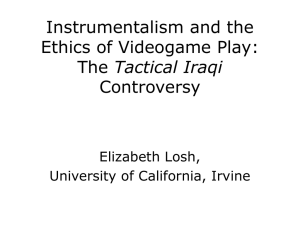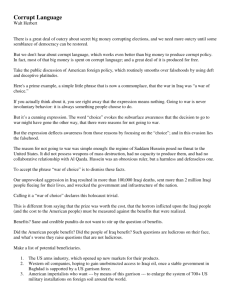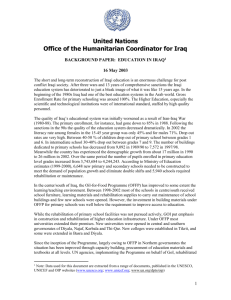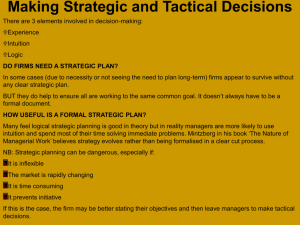virtual tourism and tours of duty in tactical iraqi and
advertisement
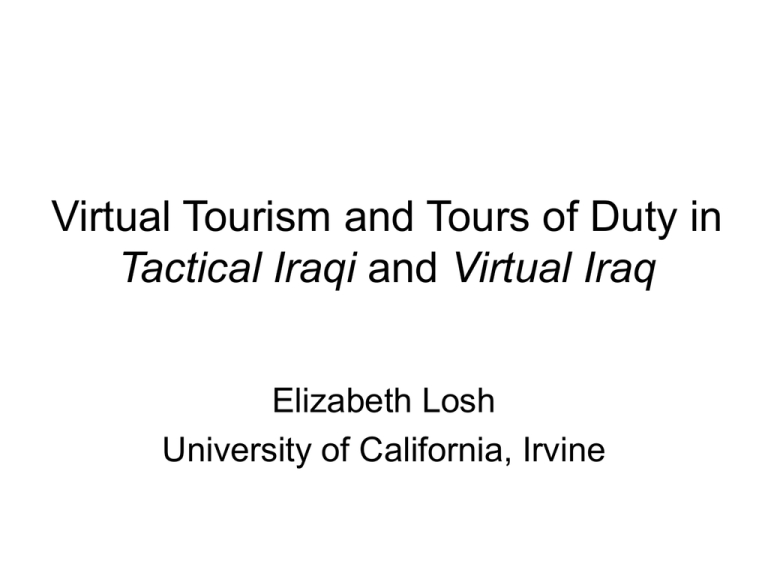
Virtual Tourism and Tours of Duty in Tactical Iraqi and Virtual Iraq Elizabeth Losh University of California, Irvine Military Users and VR More accustomed to bulky gear and wearing specialized goggles. More familiar with navigating a screen environment that represents local real-world topography. More habituated to displays with functions that can reshape landmarks and terrain. A Rhetorical History in Classical Rome: According to a famous narrative by Cicero, the Method of Loci originated in a personal disaster that took place in the life of the rhetorician Simonides of Ceos, who then created “artificial memory.” The Palace of Memory Memory was one of the five canons of classical rhetoric, although it is often considered less important in the era of computing technologies. The Method of Loci orients a rhetorical subject in a 3-D environment to create particular mental associations while moving through sequences of discrete scenes. The contemporary research of Yates and Carruthers attempts to relegitimize these cultural practices. Abbey Memory System Johannes Romberch, Congestorium Artificiose Memorie, 1533 Paradise as Artificial Memory Cosmas Rossellius, Thesaurus Artificiosae Memoriae, 1579 Is Memory Obsolete? For much of the twentieth century memory was devalued in the canon of rhetoric, and invention was lauded. Now, with ubiquitous computing and powerful search engines, is the construction of organic memory of any continuing importance? Wong and Storkerson In virtual environments, however, associative processes of cognition could assert their importance again. The Reverse Memory Palace Making Environments to Suit Rhetoric Michael Heim on “Avatecture” in the CyberForum@ArtsCenter that also uses the work of W.S. Mitchell “The Human Terrain” Policy analyst Max Boot in an editorial in The Los Angeles Times The FlatWorld mixed reality facility at USC’s ICT Tactical Iraqi A Pre-History of Tactical Iraqi The Center for Advanced Research in Technology for Education (CARTE) at the Information Sciences Institute of the University of Southern California previously authored a range of imaginative but seemingly disconnected distance learning initiatives that featured computer generated animated agents, software capable of expressive speech analysis and synthesis, and programs organized around the presentation of pedagogical drama. Mission Game Skill Builder Arcade Game What are the core problems that Tactical Iraqi is designed to solve? A chronic shortage of Arabic speakers among military personnel A combat environment in ambiguous urban warfare settings of occupation and reconstruction A resistance to classroom language instruction in the planned population of learners Social and Perceptual Realism What common rituals make us more likely to identify a given situation as realistic? Alison McMahan How does the agora function in digital spaces? (The agora is the environmental bubble in which social exchange and mutual appropriation is permissible according to Ostwald.) A Pre-History of Embodied Language Learning Georgi Lozanov: Suggestology and Suggestopedia Constraining Transgressive Play James Paul Gee has argued that there are pedagogical benefits to challenging the norms of explicit instruction in situated learning contexts. Yet military videogames generally punish transgressive play and limit exploration of the virtual environment, to such an extent that human subjects at first avoided the game space of Tactical Iraqi entirely or “cheated” to reach the ostensible rewarded objective. The Commercial Market for Language-Learning Software The Living Language series models norms of politeness in which interactions are highly regulated and proprietary rights to the physical space is not contested. “Knock and Talk” Missions How do soldiers learn to follow very different rhetorical rules? How is personal space negotiated? How do strategies and tactics differ? Is there a role for politeness? Positive and Negative Face Brown and Levinson recommend negative politeness as the safer course. Yet military missions may necessarily constrain the spatial freedom of others during interrogation, search, or arrest. Virtual Tourism What are the effects of architectural pastiche? How is the area of game play constrained? Virtual Iraq A HMD exposure therapy simulation that uses digital assets from other ISI/ICT projects and Full Spectrum Warrior. The object of the simulation is to allow the patient to create personal narratives about real-life traumatic events that foster psychic integration rather than the symptomology or dissociation of PTSD. Some versions of the simulation use a motion platform and/or scent release device. A Pre-History of Virtual Iraq Brain injured patients or stroke victims need spatial cues to reacquire particular cognitive associations. A modern form of the method of loci operates by rebuilding intellectual function by fostering interaction with the virtual environment. Telemedicine Rehabilitation and training in virtual environments for amputees, spinal injury patients, the blind, and the developmentally disabled. Virtual Classroom Albert “Skip” Rizzo ADHD Children Virtual World Trade Center Cornell and the University of Washington Virtual Vietnam Jarrell Pair and researchers at Georgia Tech Virtual Bus Bombing Tamar Weiss, University of Haifa The Spatialization of Memory in the work of Jacki Morie The Memory Stairs DarkCon The Rhetoric of Walking Michel de Certeau Ian Bogost, the figure of the flaneur, and the concept of “Procedural Rhetoric” Differences • Tactical Iraqi is a game, and Virtual Iraq is a simulation. • Tactical Iraqi has pedagogical goals, and Virtual Iraq has therapeutic ones. • Tactical Iraqi uses third-person perspective, and Virtual Iraq uses firstperson. • Tactical Iraqi rapidly switches contexts, and Virtual Iraq is immersive. Similarities • Both programs recreate segments of the landscape, built environment, and population of Iraq in 3-D worlds. • Both are developed by teams in close physical proximity under the auspices of the same university. • Both require a high degree of trust from userparticipants. • Both use off-the-shelf game technology that has had a history in the consumer market. • Both have attracted considerable news coverage in the mainstream media. • Both connect memory development to discrete scenes in digital experience. Showing pervasive problems being solved could potentially create political spectacles The shortage of Arabic speakers Post-Traumatic Stress Disorder among the veteran population The difficulty of locating improvised explosive devices Ambush! from BBS, another DARWARS project Mainstream Media Coverage Tactical Iraqi Virtual Iraq • Newsweek • USA Today • The Los Angeles Times • The New York Times • National Geographic • Forbes • BBC • National Public Radio • ABC News • • • • • • • • • BBC National Public Radio CNN ABC CBS Reuters Newsweek The Washington Post The Los Angeles Times Is there a rhetorical function to making training, language-learning, or therapy visible to the public? Regardless of the intentions of their creators, are policy-makers motivated to fund projects that show intractable problems being tackled regardless of their efficacy? If audiences for broadcast media in the general public do not participate in interactive experiences do they have any opportunity for ideological critique? Slavoj Žižek: “Welcome to the Desert of the Real” By using the film The Matrix as an analogy, Žižek argues that until the attacks of September 11th, the U.S. was shielded by an artificial but ideologically comforting socio-economic, political, and cultural virtual reality environment that separated it from the violence and privation of the rest of the world. “If there is any symbolism in the collapse of the WTC towers, it is not so much the old-fashioned notion of the ‘center of financial capitalism,’ but, rather, the notion that the two WTC towers stood for the center of the VIRTUAL capitalism, of financial speculations disconnected from the sphere of material production. The shattering impact of the bombings can only be accounted for only against the background of the borderline which today separates the digitalized First World from the Third World ‘desert of the Real.’” Ironically, since those attacks, government agencies have created even more VRE’s so that games and simulations can safely model military and public health situations of crisis. When the consequences of error are so high, VRE simulation would seem to create a logical testing ground for purposive action. In particular, a number of “Virtual Iraqs” were to have been recreated; these included plans to construct a digital replica of the looted National Museum in Baghdad. Yet the portability of digital assets poses challenges to designers state-side who are not cleared for secure access to certain photographic reference materials, such as those from the Green Zone. Making Things Public Taxpayer-Funded Games as Public Property “Scientific laboratories, technical institutions, marketplaces, churches and temples, financial trading rooms, Internet forums, ecological disputes – without forgetting the very shape of the museum inside which we gather all those membra disjecta – are just some of the forums and agoras in which we speak, vote, decide, are decided upon, prove, are being convinced.” Bruno Latour Summation: What’s unsettling about these games and simulations? 1. The Palace of Memory is actually underutilized. 2. Interaction with the spatial environment is highly regulated. 3. Secondary audiences can only experience the spatial environment passively. 4. The danger of creating political spectacles is not acknowledged. 5. Virtuality creates an ideological alienation effect. Acknowledgements My thanks to Lewis Johnson of the Information Sciences Institute for allowing me to interview him about this project and for access to his published studies, game scripts, character descriptions, and personal reflections in several follow up e-mail exchanges. I am also very grateful to Albert “Skip” Rizzo of the Institute for Creative Technologies, who permitted an extensive interview allowed me to use the system twice and shared his rich archive of digital files that demonstrate virtual reality exposure techniques and clinical findings. What isn’t here about Tactical Iraqi . . . A critique of its assumptions about the identity position of the user, particularly in regard to nationality, class, sexuality, and gender. An exploration of the cryptohistory of the game’s development and its migration from “face” to “trust” to “etiquette” as the core explanatory narrative. An analysis of the debate in the game development community about working on a military-funded videogame by looking at competing philosophies of instrumentalism. My e-mail and web addresses lizlosh@uci.edu http://eee.uci.edu/faculty/losh http://www.virtualpolitik.org http://www.digitalrhetoric.org
